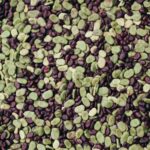The Purple Hyacinth Bean is a beautiful, colorful addition to any garden and a great choice for those looking to add some vibrancy to their outdoor space. With its bright purple blooms, this perennial vine is sure to be a showstopper in any garden. Growing and caring for Purple Hyacinth Bean plants can be an enjoyable experience with the right knowledge and understanding of its needs.
As a specialist in botany and gardening, it is my pleasure to provide you with the necessary information on how to grow and care for the Purple Hyacinth Bean. If you are looking for an easy-to-care-for vine that will bring your garden alive with vibrant color, then look no further than the Purple Hyacinth Bean. It’s not only aesthetically pleasing but also provides a wonderful opportunity to serve others through your gardening efforts.
In this article I will discuss the best ways to grow and care for your Purple Hyacinth Bean plants so that they thrive in your garden year after year. From planting tips and watering requirements, to fertilizing advice and pruning techniques – I’ll provide you with everything you need to know about this stunning annual vine!
Choosing A Location For Purple Hyacinth Beans
Planting a purple hyacinth bean is like creating a vibrant palette of colors in your garden. These beautiful plants will give your garden an added dimension of beauty and make it a pleasure to behold. As with any flower or plant, choosing the right location for the purple hyacinth bean is essential for its success.
When selecting a spot for your purple hyacinth beans, you should consider several factors. First, it should be somewhere that gets plenty of sunlight throughout the day; these plants prefer full sun to partial shade. Second, they need good drainage; avoid planting in areas that become waterlogged or overly wet. Third, they will benefit from some support; pick an area with sturdy structures like fences or trellises nearby. Finally, keep in mind that this plant can spread rapidly, so choose an area where it won’t become too invasive.
Once you’ve chosen the ideal location for your purple hyacinth beans, it’s time to begin planting them! Start by preparing the soil: loosen it up by working in some compost and adding additional fertilizer as needed. Then carefully place the seeds about three inches apart and lightly cover them with soil. Water regularly and provide frequent weeding and pruning to ensure that your plants have ample room to grow and bloom brightly!
Planting Purple Hyacinth Beans
When planting purple hyacinth beans, it’s important to choose the right location. Soil should be well-drained and slightly acidic. If you can, amend the soil with organic matter such as compost or aged manure before planting. Plant seeds 1 inch deep in rows that are 12 inches apart, spacing the individual seeds about 4 inches apart. Water immediately after planting and keep the soil moist until germination occurs.
For an added boost, you can add a slow-release fertilizer at a rate of 2 pounds per 100 square feet when planting your beans. When planting multiple rows, leave enough space between them for easy access when weeding or harvesting later on. As the plants grow, thin out any weaker seedlings to ensure strong growth for those left behind.
It’s best to wait until late spring or early summer to plant purple hyacinth beans in order to provide them with warmer temperatures and more sunlight hours throughout their growing season. With the right conditions and care, these vines can produce beautiful purple flowers in no time!
Watering Purple Hyacinth Beans
Purple hyacinth beans are a beautiful, easy to grow flowering vine that can add a splash of color to any garden or patio. In fact, these plants can reach up to twenty feet in height and produce fragrant purple flowers throughout the summer months. When it comes to watering purple hyacinth beans, the key is to keep them consistently moist but not soggy. It’s important to note that too much water can cause root rot and other diseases.
A good rule of thumb for watering is to check the soil every few days with your finger. If it feels dry an inch below the surface, it’s time to give your plant a drink. Aim for about an inch of water per week during the growing season. Use a soaker hose or drip irrigation system if you have one available, as this will help ensure that your plants are getting enough water without becoming over-saturated.
For those who live in particularly dry climates, mulching around the base of your plants can help retain moisture in the soil and reduce water requirements. Additionally, be sure to provide adequate air circulation around your plants by pruning back any dead or dying stems and leaves regularly throughout the growing season. By following these simple steps, you can provide your purple hyacinth beans with necessary hydration while maintaining their beauty all summer long!
Fertilizing Purple Hyacinth Beans
Fertilizing purple hyacinth beans is akin to giving them a nutrient-rich, balanced diet. It’s essential for beautiful blooms and healthy foliage to become a vibrant addition to your garden. With the right techniques, you can ensure that your purple hyacinth beans will thrive and grow strong.
First, it’s important for gardeners to understand the type of soil in which their plants are growing. Purple hyacinth bean plants prefer light, well-drained soil that is slightly acidic or neutral in pH. If your soil is heavy and clay-like, adding compost or other organic material can help improve drainage and aeration. Additionally, adding aged manure or a slow-release granular fertilizer can help keep your plants healthy throughout the season.
When fertilizing purple hyacinth beans, it’s best to do so at least twice during the growing season—once when planting and once again after blooming has finished. Use an all-purpose fertilizer with an N-P-K ratio between 5:10:10 and 10:10:10; this will provide adequate nutrition for the plant while encouraging lush foliage growth and abundant flower production. For additional nutrients, consider adding Epsom salts or liquid seaweed fertilizer every two weeks during the growing season.
By following these fertilizing guidelines and understanding how best to nourish your plants, you’ll be able to ensure that they remain healthy and robust throughout the season—and beyond!
Common Problems When Growing Purple Hyacinth Beans
Growing purple hyacinth beans can be a rewarding experience, as it allows gardeners to add beautiful and vibrant colors to their landscape. However, there are several common problems that can arise when attempting to cultivate this type of legume. In this section, we’ll discuss five common issues that may occur during the cultivation process.
First off, inadequate drainage can lead to waterlogging in the soil which prevents oxygen from reaching plant roots. This is especially true for heavier soils such as clay loam or silt loam. To prevent this from occurring, gardeners should ensure their soil has adequate drainage by digging trenches or holes in the planting area prior to planting. Additionally, it’s important to consider the amount of sunlight that is available for the plant when choosing an appropriate location for growing purple hyacinth beans.
Second, nutrient deficiencies can also cause problems with growth and development of these plants. Too little nitrogen or phosphorus can stunt growth while too much nitrogen can cause foliage discoloration and poor flowering display. As a result, it’s important to check soil fertility levels before planting and supplement with fertilizers if necessary. Additionally, adding compost or other organic matter will help improve soil structure and promote healthy root growth.
Finally, over-watering is another issue that arises when cultivating purple hyacinth beans. Too much water drowns plants by preventing oxygen from reaching roots and eventually resulting in wilting and death of the plant material. Therefore, proper irrigation practices must be followed in order to ensure optimal moisture levels in the soil are maintained throughout the growing season. Additionally, raised beds can help reduce runoff and provide better control over irrigation amounts than conventional garden beds do.
By understanding these common problems related to growing purple hyacinth beans, gardeners will be better equipped to successfully cultivate them in their own garden.
Controlling Pests And Diseases Of Purple Hyacinth Beans
Pests and diseases can significantly affect the growth of purple hyacinth beans. It’s important to be aware of the potential problems they may face and how to control them. This article will provide an overview of how to protect your plants from pests and diseases.
The first step in controlling pests and diseases is prevention. To do this, you should keep your plants well-nourished by providing adequate water, sunlight, and soil fertility. Additionally, make sure to remove any weeds or other vegetation that could harbor pests or disease-causing organisms near your plants.
Next, it’s essential to regularly inspect your purple hyacinth bean plants for signs of infestation or infection. Common pest problems include aphids, caterpillars, slugs, and spider mites. For fungus-related issues such as mildew or brown rot, there are a variety of fungicides available for purchase at garden stores. Make sure to follow the directions carefully when applying these products for best results.
If all else fails and you still have an issue with pests or diseases on your purple hyacinth beans, then it may be time to consider pruning or deadheading them in order to help reduce the spread of any further infections or infestations. This article has provided an overview of how to protect your plants from pests and diseases; now let’s take a look at pruning and deadheading techniques for purple hyacinth beans.
Pruning And Deadheading Purple Hyacinth Beans
Pruning and deadheading purple hyacinth beans may seem like a tedious task, but it is an essential part of their care. Not only does it ensure that your plants look better, it will also give them more energy to grow more quickly and produce more flowers. For those of us who are new to gardening, the thought of pruning can be intimidating. However, by understanding the basics of pruning and deadheading these plants, you’ll be able to keep your purple hyacinth bean plants looking beautiful all season long.
First, let’s take a closer look at why pruning is important for these plants. Pruning helps promote healthy growth by removing old or weak stems as well as dead leaves and flowers. This encourages the plant to produce new growth which can result in larger blooms and healthier foliage. Deadheading also helps keep the plants looking tidy by removing spent flowers before they can form seed pods which can detract from the overall appearance of your garden bed. Additionally, removing dead flowers helps prevent the spread of diseases that may be present on them.
Finally, it’s important to know how and when to prune these plants properly in order to achieve optimal results. The best time to prune is during late winter or early spring when the plant is still dormant; this allows you to remove any damaged areas without damaging new growth that has yet to emerge. When trimming off stems or leaves, always make sure that you cut at least two inches below the damaged area so that new stems have room to grow back in its place. Additionally, avoid cutting into green wood as this can encourage disease or rot in the plant material. With a bit of patience and care, you’ll be able to keep your purple hyacinth bean plants looking great all season long!
Harvesting Purple Hyacinth Beans
Harvesting purple hyacinth beans is an important step that many gardeners overlook. The best time to harvest the beans is when they are young and tender, as this is when they are at their sweetest and most flavorful. To ensure maximum flavor, the beans should be harvested before the pods become overly large and woody, which can occur quickly during hot summer weather. It’s essential to check your plants regularly for ripe beans, as harvesting them at the right stage will make all the difference in taste and texture.
When harvesting purple hyacinth bean pods, it’s important to use sharp pruners or scissors to cut off each pod individually. If you try to pull them off, you may damage the plant. Once you’ve harvested the beans, you should discard any that have blemishes or discoloration on them. Additionally, you should remove all of the bean strings before cooking with them; these can be tough and fibrous if cooked in with the pods.
Once your purple hyacinth beans have been harvested and trimmed as needed, they can be used immediately or stored for later use. Storing them correctly will help preserve their freshness and flavor – keep reading our article to learn how!
Storing And Preserving Purple Hyacinth Beans
Storing and preserving purple hyacinth beans is an important part of the gardening process. From harvesting to keeping the beans, there are several steps involved in ensuring that your crop of purple hyacinth beans will remain fresh and flavorful for longer. Here’s how to store and preserve them:
Firstly, it is best to harvest your purple hyacinth beans when they are at their prime — when they are young, tender, and still green. This will ensure that they stay as fresh as possible when stored. Secondly, you should remove any excess soil or debris from the beans before storing them.
Once the purple hyacinth beans have been harvested and cleaned, there are two main methods of storing them: short-term storage and long-term storage. For short-term storage, keep the beans in a cool dry place with plenty of air circulation. They can be stored in a plastic bag or container lined with paper towels for up to two weeks. If you plan on using the beans within this time frame then this method is ideal for you.
For long-term storage however, freezing is the most effective way to preserve your purple hyacinth bean crop for extended periods of time. To freeze your beans, simply blanch them in boiling water for about three minutes before transferring them into cold water to cool down quickly. Once cooled, drain off any excess liquid and place them into sealed freezer bags or containers before placing them into your freezer where they can be safely stored for up to one year.
By following these simple steps when storing and preserving your purple hyacinth bean crop you can ensure that it remains flavorful and fresh all year round!
Companion Planting For Purple Hyacinth Beans
Tending to plants can seem like a daunting task, but companion planting for purple hyacinth beans is actually quite straightforward. Who knew something so simple could yield such beautiful results? As one of the most popular varieties of vines, the plants look stunning when grown together in a garden.
Companion planting involves grouping certain plants together in order to maximize their growth potential and increase yields. For example, it’s best to pair purple hyacinth beans with tomatoes or corn, as they can provide each other with nutrients and protection from pests. Additionally, marigolds are recommended since they repel various types of insects that may try to feed on the vines.
The trickiest aspect of companion planting is making sure there’s enough space between the two species so they don’t interfere with each other’s growth patterns. To do this, it’s important to research how large the plants will grow and plan accordingly. Once you’ve done that, however, all that’s left to do is keep an eye on them and enjoy the majestic beauty of your purple hyacinth bean creations!
Popular Varieties Of Purple Hyacinth Beans
The beauty of the purple hyacinth bean has been admired for centuries, especially in warmer climates. It’s a unique addition to any garden, and its showy flowers are simply stunning. Let’s take a look at some popular varieties of this vibrant plant.
To begin with, let’s consider the ‘Royalty Purple Hyacinth Bean’. This variety features deep violet blooms and lush green foliage that contrasts beautifully against its velvety purple pods. Its vigorous growth habit makes it an ideal choice for gardeners looking to add a touch of color and texture to their landscapes.
For those who prefer a more subtle look, there’s the ‘Purple Moon’ variety. This variety has smaller, lighter purple flowers and glossy dark green leaves. It also has an incredibly robust root system, making it one of the most drought-tolerant varieties around.
No matter which variety you choose, you’ll be sure to have a stunning addition to your garden that will thrive for years to come!
Benefits Of Growing Purple Hyacinth Beans
Besides their aesthetic value, purple hyacinth beans come with a multitude of benefits that make them one of the most sought-after plants in gardens and landscapes. With a little bit of care and attention, these gorgeous legumes can bring abundant beauty and life to any outdoor space. Let’s take a look at why you should include purple hyacinth beans in your landscape design.
To begin with, these lovely plants are incredibly easy to grow and maintain. The seeds are large enough for even inexperienced gardeners to handle without difficulty, and they germinate quickly once planted in the ground. While purple hyacinth bean plants need plenty of water, they are drought tolerant once established and are not overly susceptible to pests or diseases. This means you can enjoy their attractive foliage throughout the season without worrying too much about maintenance!
Furthermore, their bright flowers will attract pollinators such as bees and butterflies to your garden – providing vital support for local wildlife populations. Plus, because purple hyacinth beans are nitrogen-fixing plants, they help improve soil fertility as well! This makes them an excellent choice for sustainable landscaping projects as they ensure your garden remains healthy over time.
TIP: Plant purple hyacinth bean seeds around mid-springtime when temperatures begin to rise – this will give them plenty of time to establish themselves before winter arrives.
Using Purple Hyacinth Beans In Landscapes
Growing purple hyacinth beans is a great way to bring vibrant color to any garden. The deep purples and blues of these delicate blossoms will create an eye-catching display that is sure to inspire a feeling of awe in any onlooker. As an added bonus, the beans can also be used in landscaping projects as a beautiful and low-maintenance option for outdoor spaces.
For starters, these plants make excellent additions to rock gardens or other areas with limited soil space. Their sprawling vines are perfect for cascading over walls or along pathways, providing a lush backdrop that softens the look of hardscaping elements while adding visual interest and texture. When planted in containers, they provide height and contrast against surrounding plantings while still requiring minimal effort on the part of the gardener.
In addition to their use as ornamental plants, purple hyacinth beans can also be harvested for their edible seed pods and pods that have been dried out for use as decorations or crafts. For landscape design purposes, their bright flowers make them ideal for naturalizing areas along driveways or walkways where they can attract pollinators like bees and butterflies without taking up too much space. Whether you choose to grow them in ground beds or containers, purple hyacinth beans are sure to add beauty and charm to your outdoor area.
Tips For Growing Purple Hyacinth Beans
Growing purple hyacinth beans can be a rewarding and satisfying experience. They are an ornamental vine that is well suited to many landscapes, adding beauty and color to your garden. To ensure their success, there are some tips you should follow while caring for them.
Firstly, it’s important to choose the right location to plant them in. Look for a spot that gets full sunlight, has well-draining soil and is protected from strong winds. Adding compost or manure to the soil before planting will help provide the beans with the nutrients they need for healthy growth.
Secondly, when it comes to watering your purple hyacinth beans, water deeply but less frequently; this encourages deep rooting and helps prevent fungal diseases from developing on the plants. Here are some additional tips that will benefit your beans:
• Provide support for the vines as they grow. • Mulch around plants to retain moisture in the soil. • Prune back plants as needed throughout the growing season. • Fertilize regularly with a balanced fertilizer at half strength during spring and summer months. • Pinch off spent flowers and seed pods for continuous blooming throughout summer until frost arrives.
By following these tips you can guarantee lush growth of beautiful purple hyacinth bean plants in your landscape! It’s also helpful to be aware of common problems that may affect these plants so that you can take corrective action if necessary; this will be discussed in detail in the next section.
Troubleshooting Common Problems With Purple Hyacinth Beans
As a specialist in botany and gardening, I’m here to help you with troubleshooting common problems with purple hyacinth beans. It’s important to understand the growing environment these plants prefer and how to address any issues that may arise.
One of the most common issues is inadequate soil drainage. Be sure the soil is well drained and contains plenty of organic matter. If it doesn’t, consider adding aged compost or aged manure to increase water retention and aeration. Additionally, overwatering can cause yellowing or wilting of the leaves, so make sure you’re not overdoing it.
Finally, purple hyacinth bean plants are susceptible to pests like aphids and spider mites. To prevent infestations, keep an eye out for signs of pests such as webbing on the leaves or clusters of bugs on the stems or undersides of leaves. Treat affected areas with an insecticidal soap solution as soon as possible; if left untreated, pest infestations can quickly get out of control.
With proper care and attention, your purple hyacinth bean plants should thrive! All it takes is a bit of knowledge about their preferred growing conditions and a watchful eye for potential problems.
Frequently Asked Questions
How Long Does It Take For Purple Hyacinth Beans To Grow?
Growing purple hyacinth beans is a rewarding and easy gardening experience. With its vibrant purple flowers, the plant adds a unique visual element to any garden. But how long does it take for these beans to grow?
In general, it takes about two months for the purple hyacinth bean plants to reach maturity. This includes: • Germination of the seeds within 2-3 weeks • Plant growth of 4-6 inches in height • Blooming of purple flowers within 2 months • Growth of pods with beans in them in 1-2 months • Harvesting of the pods and beans about 8 weeks after planting
As a specialist in botany and gardening, I advise that you provide ample water to the soil during all stages of growth, as well as consistent fertilization throughout its development. Make sure that the soil is well drained so that your plants can have enough space to grow without getting waterlogged. Additionally, be sure to choose an area with plenty of sunlight when planting your purple hyacinth bean seeds – this will help optimize their growth and blooming potential.
By following these tips and devoting some time each week to caring for your plants, you will be rewarded with beautiful purple flowers and delicious beans. It will also bring a sense of satisfaction knowing that you have provided a safe environment for your plants to flourish and thrive!
Is It Necessary To Prune And Deadhead Purple Hyacinth Beans?
Pruning and deadheading in gardening is an important part of caring for your plants, so it’s no surprise that many gardeners also ask if they have to do this with their purple hyacinth beans. The answer is yes! Pruning and deadheading these plants will help them look better, stay healthy, and live longer.
Pruning is the practice of cutting off old or damaged stems and leaves from the plant. This encourages new growth and helps keep the plant looking neat and tidy. Deadheading means removing spent flower heads or seed pods before they can go to seed. This will help prevent unwanted seedlings from popping up around your garden and taking over.
Both activities should be done regularly throughout the growing season – at least once a month is recommended for optimal results. However, you should be careful not to remove too much foliage or you may end up damaging your plant. It’s best to start slow and gradually increase the amount of pruning/deadheading as needed in order to keep your purple hyacinth bean looking its best all season long!
Are There Any Benefits Of Growing Purple Hyacinth Beans In Containers?
Growing purple hyacinth beans in containers yields many benefits. According to a survey conducted by the National Gardening Association, almost 25% of Americans are growing plants in containers in their homes or on their patios. As such, it is certainly worth considering how to maximize the growth and health of these beautiful plants.
One of the primary advantages of growing purple hyacinth beans in containers is that they are relatively easy to care for. Plants grown in pots require less frequent watering than those planted directly in the ground, making them an ideal choice for beginner gardeners or those with limited time. Additionally, since the soil stays contained within the container and not exposed to outside sources, pests and diseases are far less likely to affect your plants.
Purple hyacinth beans also have aesthetic value when grown in containers – they can be used as a focal point on a patio or balcony and their striking hue will add vibrancy to any outdoor space. Furthermore, as long as you select a larger pot that provides sufficient drainage, you can easily repot and transplant your plants as needed without having to dig up soil from the ground. This makes it simpler for you to move your plant if necessary due to changing conditions or weather patterns.
Overall, growing purple hyacinth beans in containers offers numerous advantages and can help you create a vibrant outdoor space that is easy to maintain and care for. With proper attention and pruning methods, these beautiful plants will thrive in both indoor and outdoor settings.
How Often Should I Water Purple Hyacinth Beans?
Satire: In the world of gardening and botany, there are few questions that elicit more debate than how often one should water purple hyacinth beans. From the novice gardeners to the experts, all having an opinion on the matter, it can be quite a controversial topic.
As an expert in botany and gardening, I can tell you that when it comes to caring for these beautiful plants, proper watering is key. While they require a minimum amount of water to survive and thrive, too much can cause them to be susceptible to pest infestations or root rot.
The best way to ensure your purple hyacinth bean plants stay healthy is to water them regularly but not too frequently. Aim for once every week or two during active growth periods, with less frequent watering in winter when the plant is dormant. When watering, make sure the soil is moist but not soggy; this will help keep your plants looking their best and prevent any unnecessary stress on their root systems.
To provide your purple hyacinth beans with optimal care you should also provide additional nutrients such as compost or fertilizer throughout their growing season. Doing so will give them the boost they need to produce strong foliage and gorgeous blooms!
Is There A Certain Time Of Year When I Should Plant Purple Hyacinth Beans?
When it comes to planting purple hyacinth beans, timing is everything. According to research, the best time of year to plant these beautiful plants is in early spring or late summer. This gives the plants enough time to establish themselves and blossom before the cold weather sets in. So if you want your garden to be filled with vibrant purple blooms all season long, then it’s important to plan ahead and get those beans planted at just the right time!
As a specialist in botany and gardening, I can tell you that purple hyacinth beans are fairly easy to take care of once they’re planted. They require little maintenance throughout their growing period, but will need regular watering during hot spells. To ensure your plants stay healthy and vigorous, make sure you water them once every week or so – especially during periods of drought.
Your efforts will be rewarded with a magnificent display of purple sprays throughout the warm months; not only do the flowers look stunning, but they also attract pollinators like bees and butterflies too! Plus, when fall rolls around you’ll have plenty of seeds for next season’s crop – so don’t forget to let some of those pods dry on the vine before harvesting them! With a bit of planning and effort now, you can enjoy an impressive display of purple hyacinth bean blooms all summer long.
Conclusion
The purple hyacinth bean is a beautiful and easy to care for plant that can be enjoyed all season long. With its deep purple foliage, this stunning vine adds color and texture to any garden or container. Its vigorous growth, low maintenance needs and tolerances to drought make it an ideal choice for gardeners of all levels of experience.
To care for a purple hyacinth bean, simply provide it with ample room to grow, water it regularly and deadhead as needed. Planting in the late spring will give the beans plenty of time to mature before cooler temperatures arrive in fall. With regular pruning, you can keep the vines from taking over your garden or container while still enjoying its beauty.
In conclusion, growing a purple hyacinth bean is a rewarding experience that yields beautiful results. Its hardiness makes it the perfect choice for both novice and experienced gardeners alike. So if you’re looking for an attractive addition to your landscape or container garden, consider adding these unique plants!





























